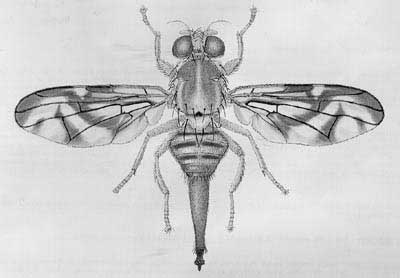common name: a fruit fly
scientific name: Anastrepha ocresia (Walker) (Insecta: Diptera: Tephritidae)
Introduction - Synonymy - Distribution - Identification - Life History - Hosts - Selected References
Introduction (Back to Top)
Anastrepha ocresia (Walker) is one of six species of fruit flies of the genus Anastrepha that occur in Florida or which have been established in Florida at some time. There is a distinct possibility that this species has not survived in Florida. It is not considered to be of economic importance anywhere within its range.
Synonymy (Back to Top)
Trypeta ocresia Walker
Trypeta tricincta Loew
Acrotoxa ocresia (Walker)
Anastrepha tricincta (Loew)
Distribution (Back to Top)
It is recorded from Cuba, Hispaniola, Jamaica, Puerto Rico and the United States. Except for the holotype female (British Museum), the species has not been collected on Jamaica. Other specimens are from the Isle of Pines, the eastern and western tips of Cuba, and Santo Domingo City, Hispaniola. A specimen that subsequently was described by Loew as Trypeta tricincta, a synonym of A. ocresia (Walker), was collected aboard ship 60 miles northwest of St. Nicholas, Haiti, but its origin is unknown.
In the U.S., this West Indian species has been collected only in Florida Keys, from Key Largo to Key West. The Florida records are from Rock Harbor, Key Largo Key, 7 July 1936, and from Key West, 28 March 1936. It has not been found since then.
Identification (Back to Top)
This is a small orange brown fly with patterned wings, banded abdomen, and a somewhat long ovipositor sheath. The wing pattern is predominantly dark brown. The distal arm of V band is present, separated from the proximal arm, or narrowly joined to side of latter at M1+2; proximal arm of V band usually extending forward to vein R4+5 but not joined to S band; costal and S bands connected, the hyaline spot usually not touching vein R4+5; wing 6.6 to 7.5 mm long.
The thorax is orange brown, with pale-yellow and black markings; the black markings consisting of a median spot lying in a brownish band on the scutoscutellar suture, acute anteriorly, usually notched posteriorly, and metanotum except for a narrow median stripe. The macrochaetae is black with the pile pale yellowish. The abdomen is orange brown, with transverse brownish-black bands on tergites 2 through 4 basally, not reaching lateral margins, and those on tergites 3 and 4 narrowed or broken medially.

Figure 1. Adult female. Drawing by Division of Plant Industry.
The ovipositor sheath of the female is 3.6–3.9 mm long. The ovipositor itself is approximately 3.3 mm long and stout, with many fine, blunt teeth on a little more than the posterior half.
Figure 2. Ovipositor tip of adult female. Drawing by Division of Plant Industry.
Life History (Back to Top)
The life history of Anastrepha ocresia has not been ascertained.
Hosts (Back to Top)
It has been reared from sapodilla, Manilkara zapota, and common guava, Psidium guajava. An adult female was also collected on grapefruit, Citrus paradisi.
Selected References (Back to Top)
- DaCosta Lima A. Sept. 1934. Moscas de frutas do genero Anastrepha Schiner, 1868 (Diptera: Trypetidae). Memorias do Instituto Oswaldo Cruz 28: 487-575.
- State Plant Board of Florida Eleventh Biennial Report for the period July 1, 1934-June 30, 1936. Anastrepha tricincta. Jan. 1937. p. 21.
- Stone A. 1942. The Fruit Flies of the Genus Anastrepha. U.S. Department of Agriculture Miscellaneous Publication No. 439. Washington, DC. 112 pp.
- White IM, Elson-Harris MM. 1994. Fruit Flies of Economic Significance: Their Identification and Bionomics. CAB International. Oxon, UK. 601 pp.
